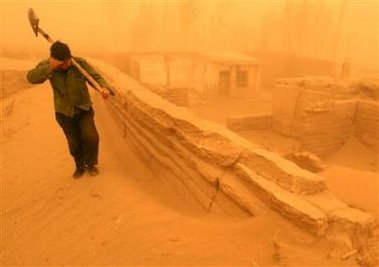
BEIJING (Reuters) - A giant dust bowl is forming across northern China, converting swathes of arable land to desert and triggering sandstorms whose impact carries across the Pacific, a leading environmentalist said on Tuesday.
Lester Brown, of the Washington-based Earth Policy Institute, said China was far from arresting the problem he attributed to overgrazing and falling water tables in the country whose landmass is already one-third desert.
"There are huge areas there that were once productive grassland that are now desert," Brown told foreign correspondents. "It represents the largest conversion of productive land to desert anywhere in the world."
China, which is plagued by sandstorms every spring, has embarked on a campaign to plant billions of trees and says it is slowing the rate of desertification, but Brown said the problem was far from under control.
"Here and there are successful pilot projects, but overall we are not anywhere close to arresting this situation. The deserts are expanding," he said.
The number of livestock grazing had mushroomed since China began economic reforms in the late 1970s, and, with little management, the number of sheep and goats jumped to 339 million, compared with about 7 million in the United States.
China has also said the sheer size of its deserts mean it will never completely tame the sandstorms that this spring covered the capital in brown dust, and left skies a murky yellow.
The dust from storms originating in China has in the past been traced all the way to the United States and Canada, Brown said.
Sandstorms were this year exacerbated by droughts across northern and western China, that were also contributing to forest fires raging in Inner Mongolia and Heilongjiang that some 20,000 firefighters were struggling to control.
Desertification, which officials at China's State Forestry Administration say is causing direct economic losses of about 54 billion yuan ($6.7 billion) a year, was also not helped by poor management of water, Brown said.
Water tables were diminishing in north China, causing rivers and land to dry out and affecting grain harvests, especially of wheat, which is grown predominantly in the drought-stricken northern provinces.
China plans to pump water from southern rivers to the parched north in a project known as the South-North water diversion scheme, but Brown said he doubted the efficacy of the plan already hampered by pollution and lack of adequate waste treatment.
Floods, mudflows and landslides triggered by days of torrential rain in parts of south China have killed at least nine people in recent days.
2 comments:
hello "butterfly effect"
Interesting website with a lot of resources and detailed explanations.
»
Post a Comment